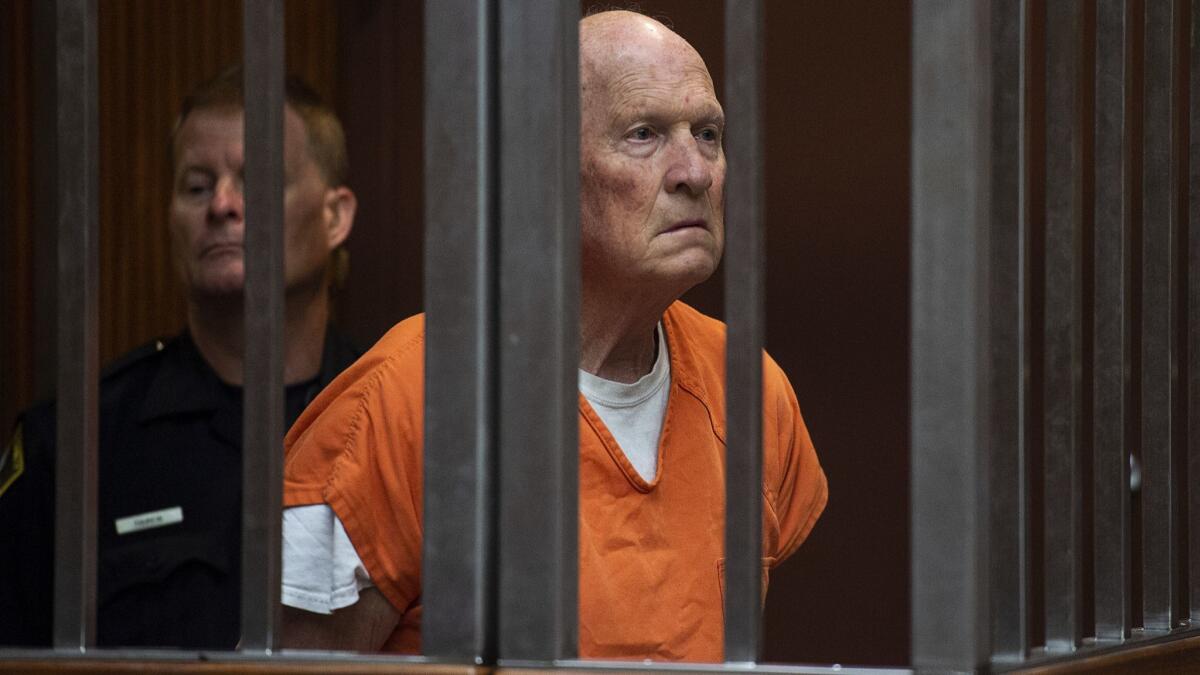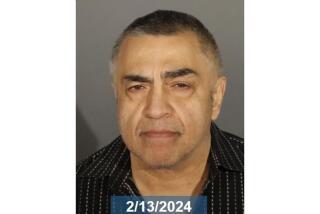DNA lifted from Golden State Killer suspect at Hobby Lobby parking lot key to cracking case, documents show

- Share via
Reporting from SACRAMENTO — The four-decade hunt for the Golden State Killer reached a turning point in April when detectives lifted the DNA of their suspect from his car door as he shopped inside Hobby Lobby, court documents released Friday show.
The secret collection occurred in a public parking lot in Roseville, just outside Sacramento. By then, authorities already considered Joseph DeAngelo Jr. a suspect but were still gathering evidence.
Authorities said in the court records that the definitive link came when the DNA taken from the car matched semen recovered at the scene of some of the Golden State Killer’s crime scene.
The documents also said detectives were able to match DNA from rapes in Northern California to several murders in Southern California, providing what prosecutors say is a key link connecting seemingly disparate crimes that had baffled authorities for years.
Judge Michael Sweet released the documents Friday after rejecting objections from DeAngelo’s defense team. An attorney representing the Los Angeles Times and other media outlets had filed a motion to have the warrants unsealed for the public record.
The documents — about 123 pages — offers the first public glimpse into the case detectives built against DeAngelo, a former police officer accused of terrorizing communities across California in the 1970s and ’80s. During that time, he is suspected of being behind at least 12 killings, dozens of rapes and more than 100 burglaries. In the warrants, detectives accuse DeAngelo of a 13th killing — the shooting death of Claude Snelling in 1975 in Visalia.
Read the full warrant and affidavit here »
Because of redactions, the documents provide only a limited sense of what prosecutors have amassed against DeAngelo. It remains unclear what investigators found after they searched DeAngelo’s home. The warrant describes dozens of rings, wedding bands, photographs and identification cards among the trinkets that DeAngelo is accused of taking from victims’ homes after committing crimes. For example, investigators hoped to find a “green Bank of American [sic] bag with silver zipper lock” that had $1,366.31 in cash. But it’s unclear whether any of these items were recovered from his Citrus Heights home.
The documents underscore how essential a novel and controversial DNA technique was used to build the case. Frustrated detectives placed DNA found at one of the crime scene on several genealogy websites. Eventually, they linked it to one of DeAngelo’s distant relatives. Detectives have said in interviews with The Times that with that familial link, they centered on DeAngelo because of his age, employment and that he lived close to where many of the crimes were committed.
With their suspect identified, detectives needed a DNA sample. They began surveillance on the one-time officer and that led them to Hobby Lobby on April 18. On April 23, they obtained a second DNA sample from a tissue in DeAngelo’s trash can outside of his home, hoping to get a more conclusive match. DeAngelo was arrested April 24.
Public defender David Lynch sought to keep as much information under seal as possible, saying release of detectives’ statements would “taint potential jurors.” He called much of the case offered up for the arrest of DeAngelo and search of his home “speculative.” DeAngelo has not entered a plea.
The names and other identifying information for at least 75 surviving victims, witnesses and detectives included in the warrant were redacted, along with details of previously suspected rapes.
Sweet ruled that a list of the evidence seized from DeAngelo’s home, computer and his phone will remain sealed.
Media lawyer Duffy Carolan said she was generally pleased with the ruling. The Sacramento County district attorney’s office emphasized that it did not ask for the records to be sealed and that 95% of the material being redacted was at the request of DeAngelo’s public defenders.
Sweet said in a verbal order that he was striving to protect DeAngelo’s right to a fair trial. He quoted Benjamin Franklin: “An ounce of prevention is worth a pound of cure.”
Half a dozen of the Golden State Killer’s victims who have been attending the Sacramento court hearings were present for Friday’s decision but asked not to be identified.
One woman had no opinion on the release of the arrest records, saying, “I don’t care, as long as it doesn’t hurt the case.”
Another woman, who said she was raped by the Golden State Killer, said she is attending DeAngelo’s court appearances “to drill holes in the back of his head.”
DeAngelo is charged with the shooting deaths of two people in Sacramento and 10 more counts of murder in three other counties, the culmination of a four-decade manhunt for a serial burglar and rapist who often hit multiple homes in a night, stole mementos from his victims or taunted them later with phone threats.
Whole communities were stricken with fear as the crime wave grew on both sides of the state and in the Central Valley starting in the early 1970s. Families bought guard dogs and guns, installed extra deadbolts on their front doors and secured their rear windows and sliding doors. Authorities say DeAngelo’s crimes covered territories in Santa Barbara, Ventura and Orange counties, where several women were raped and fatally beaten between 1979 and 1986.
One couple was found bludgeoned to death with a fireplace log in Ventura. Another was found tied up and shot to death in Santa Barbara County.
Investigators also think DeAngelo was responsible for a crime wave in Visalia that involved dozens of home burglaries, assaults and one killing. Authorities say he may have begun his criminal activity as a cat burglar in Rancho Cordova in the early 1970s.
DeAngelo worked as a police officer for small towns in California until 1979, when he was fired in Auburn for shoplifting a hammer and dog repellent. He then worked for decades as a truck mechanic, living in a suburb north of Sacramento and communities that had been terrified by sexual assaults and killings now attributed to the Golden State Killer.
After his arrest, prosecutors from Sacramento, Ventura, Orange and Santa Barbara counties met to discuss where and how to put DeAngelo on trial for the slayings because the crimes cover multiple jurisdictions. No decision has been made.
Twitter: @paigestjohn
Twitter: @JosephSerna
Twitter: @latvives
Twitter: @boreskes
UPDATES:
4:55 p.m.: This article was updated with more details from the documents.
4 p.m.: This article was updated with additional information from newly released court documents.
This article was originally published at 2:55 p.m.
More to Read
Sign up for Essential California
The most important California stories and recommendations in your inbox every morning.
You may occasionally receive promotional content from the Los Angeles Times.














